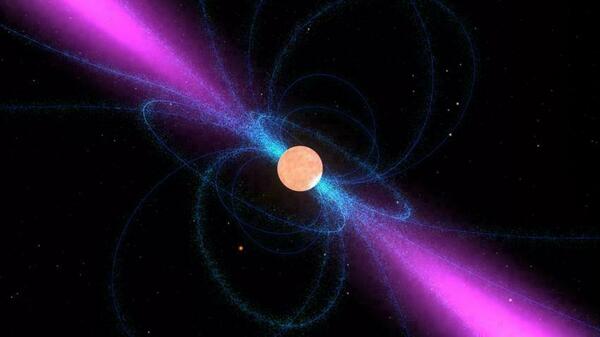
John LoSecco, professor in the Department of Physics and Astronomy at the University of Notre Dame, has discovered a novel way to potentially identify the presence of dark matter in space by using very precise celestial clocks: A type of neutron star known as a pulsar.
Pulsars are formed when a larger star explodes, leaving behind a smaller remnant that spins rapidly and produces pulses of radio waves that can be seen at precise times when they point towards the Earth — much like a lighthouse emits beams of light. LoSecco is the first to apply pulsar data to the identification of dark matter, discovering 12 signals that appear to be dark matter objects by analyzing the timing of pulsars. His novel approach captured the attention of the Royal Astronomical Society, and LoSecco recently presented his dark matter findings at their annual meeting at the University of Hull in the UK and has also submitted his work to their Journal Monthly Notices.
“A number of groups around the world have collected and made catalogs of pulsar timings with precision to the order of nanoseconds,” LoSecco said. “These are made publicly available. I was working on a related problem and one day I woke up and realized they could be repurposed to look for distortions in the arrival times [of the radio pulses].” A distortion of the pulsar’s clocklike timing indicates the presence of matter between the pulsar and the telescope.
The data used in LoSecco’s analysis came from the Parkes Pulsar Timing Array release 2 (PPTA2), which has been collected over a period of 30 years using seven different radio telescopes located around the world. These telescopes capture the radio waves of pulsars at specific time intervals and allow radio astronomers to conduct precision experiments using the collected data. The PPTA2 data set has been used by researchers to study physics questions ranging from neutron star masses to gravitational waves.
“If there were nothing between us and the pulsar, the pulses would come in very well-known and determined times…The pulse is the clock and I can see the clock slow down and speed up because it passes through matter. This means I have access to masses that are in the line of sight [of the pulsar and the telescopes],” he said.
Of note, masses located between the pulsar and telescopes do not block the pulsar’s signal, but rather distort it with their gravitational field.
“All matter creates a gravitational field, and the gravitational field extends far beyond the object,” LoSecco said. “I realized that the propagation of [a pulsar’s] pulses is sensitive to the gravitational fields that they pass through. Because they’re sensitive to gravitational fields, they [alert us] to objects that may not be emitting any other radiation – like big chunks of rock or dark matter.”
Dark matter ranges in size from elementary particles to Jupiter size planets and black holes. However, it does not interact with, absorb, or emit light, so researchers cannot see it with traditional telescopes. Instead, its presence must be inferred. Only about 20 percent of the mass researchers can quantify is comprised of objects like galaxies, stars, gas, and dust, so the remainder is dark matter.
The inability to directly visualize dark matter significantly limits ways to identify the location of dark matter objects in space and highlights the importance of Professor LoSecco’s discovery.
“Whether the dark matter is a black hole or a neutron star, you won’t be able to see it, but you will experience its gravitational field. [My] method allows us to estimate the mass [of the matter] based on the amount of time that’s lost… We need more ways to observe [dark matter] like this time delay technique with the pulsars. It’s very exciting.”
LoSecco is continuing to search the PPTA2 data set for more potential dark matter objects and hopes that these findings will further the understanding of dark matter in space.
Originally published by at science.nd.edu on August 27, 2024.